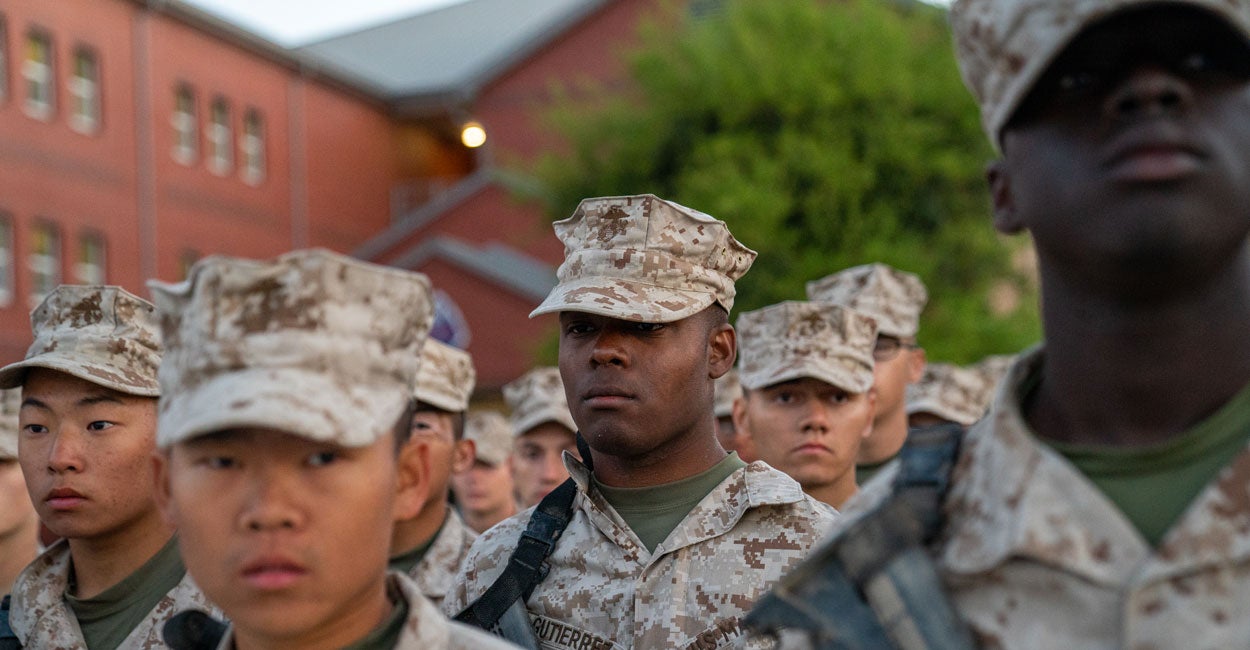Each U.S. military service saw a notable decline in white recruits over the past five years, according to data obtained by the Daily Caller News Foundation, likely factoring into the military’s crippling recruiting crisis.
The Army, Navy, and Air Force missed their recruiting objectives by historically large margins in fiscal year 2023, which ended on Sept. 30, as the broader American public has grown wary of military service, according to Department of Defense statistics, officials, and experts who spoke to the Daily Caller News Foundation.

The Daily Signal depends on the support of readers like you. Donate now
Since 2018, however, the number of recruits from minority groups has remained steady—or, in some cases, increased—while the number of white recruits has declined, according to data on the demographics of new recruits obtained by the Daily Caller News Foundation.
The data “reveals the decline of white recruits is almost entirely responsible for the recruiting crisis,” Will Thibeau, director of the American Military Project at the Claremont Institute, told the Daily Caller News Foundation.
“A smaller proportion of white Americans serve now than ever before. This is fundamental, because complimentary increases in black and Hispanic recruits have not taken place,” he added.
U.S. troops are under attack in the Middle East, maintaining a heightened posture against a belligerent Russia in Europe, and bolstering deterrence against the People’s Republic of China. The U.S. military is weakening, unable to respond to some of the most pressing challenges to U.S. national security, according to a report released by The Heritage Foundation. (The Daily Signal is the news outlet of The Heritage Foundation.)
“This is a huge blow as the recruiting crisis is the worst in the history of the all volunteer force,” Robert Greenway, director of the Allison Center for National Security at Heritage, told the Daily Caller News Foundation, referring to the plummeting numbers of white recruits since 2018.
A Dramatic Decline in White Recruits
Other demographic groups have fluctuated over those five years, but none consistently tumbled over time like the white demographic.
In fiscal year 2018, 44,042 new recruits to the Army—or 56.4% of the total—were white, according to data obtained by the Daily Caller News Foundation. That number collapsed to a low of 25,070—or 44% of the total—in fiscal year 2023.
Over the same time period, black Army recruits increased from 19.6% of the total in 2018 to 23.5% in 2023, and Hispanic Army recruits rose from 17.2% to 23.5%. However, the real number of recruits from the remaining non-white demographic groups also dipped from fiscal year 2018 to 2023, as the total number of new personnel the Army signed on each year fell dramatically, the data shows. None of these groups saw the same degree of decline as white recruits, however.
Military.com first reported the precipitous drop in the number of Army soldiers recruited in fiscal year 2023 from five years prior.
“What we’re seeing is a reflection of society; what we know less of is what is driving all of these things,” an Army official told Military.com. “There is no widely accepted cause.”
While the Army may have experienced the worst of the military’s recruiting woes, the data obtained by the Daily Caller News Foundation shows that a similar pattern exists across all branches of the armed services. White people are joining the military in lower numbers than before as other racial or ethnic groups do not demonstrate the same shortfalls.
Data for the Air Force shows that Asian recruits increased from 1,110—or 3.7% of a total 29,831 recruits—in 2018 to 1,471—or 6.1% of a total of 23,967 recruits—in 2023. While the number of black Air Force recruits was nearly identical during this period—5,144 in 2018 and 5,155 in 2023—they comprised a larger percentage of the incoming force in 2023, at 21.51%, than they had in 2018, at 17.2%, as the Air Force’s incoming classes shrunk.
White Air Force recruits, by contrast, dipped from 21,593 in 2018, or 72.4% of the total, to 15,068, or 62.9% of the total, in 2023, the data shows.
Hispanic recruits were tracked as a separate, binary measure of ethnicity. The number categorized as non-Hispanic dropped from 24,204 in 2018 to 17,913 in 2023—a decline of 6,291. At the same time, the number of Hispanic recruits increased only slightly—from 5,627 in 2018 to 6,054 in 2023.
It was unclear precisely how many white Air Force recruits also selected Hispanic as their ethnicity, or how many Hispanic recruits selected the “white” or “multiple” race category.
Data for the Space Force was not included in the Daily Caller News Foundation’s analysis.
In the Navy, the number of white recruits fell from 24,343 in fiscal year 2018 to 18,205 in fiscal year 2023, accounting for some of the overall drop of about 9,000 new recruits over the same time period, the data shows.
The numbers of black and Asian Navy recruits increased over the same period, with black recruits increasing from 6,798 in 2018 to 7,947 in 2023 and Asian recruits increasing from 1,518 to 2,075 over the same period.
As with the Air Force data, Hispanic recruits were not included in the dataset as a category.
The ethnicity of 10% of Navy recruits in 2018 was listed as “none-unknown,” but that number dropped to nearly zero by 2021, potentially clouding any true comparison of data between years. There were also small drops in recruits listed as American Indian or Alaskan Native, “multiple races,” and Native Hawaiian-Other Pacific Islander.
As in the Air Force, a separate measurement of ethnicity for Navy recruits included only two categories: Hispanic and non-Hispanic. The proportion of Hispanic recruits grew from 18% in 2018 to 25% in 2023, while the real number of non-Hispanic recruits actually dropped from 31,977 to 22,746.
Unlike with the Air Force and the Navy, the Marine Corps calculated race and ethnicity together, placing Hispanics in a separate category alongside white, African American, and “other” recruits. It also included specific data for officers and enlisted recruits, further complicating any comparison between the services.
However, this data appears to suggest that, although the Marine Corps has not struggled to meet recruiting objectives like the other services have, any decline in overall numbers of new recruits has been driven by a smaller pool of white Marines in the new cohort.
White enlisted Marine Corps recruits dropped from 21,455—58% of the total—in fiscal year 2018 to 14,287—43% of the total—in fiscal year 2023. Hispanic recruits climbed from 9,984—27% of the total—to 12,859—39% of the total. The number of black recruits did not change appreciably: 3,708, or roughly 10%, in 2018 to 3,603, or roughly or 11%, in 2023.
The “other” category for enlisted Marine recruits jumped from 1,765 to 2,574.
The largest drop in white enlisted Marines occurred between 2021 and 2022, when they declined by 3,090, accounting for most of the overall decline of 3,214.
Combining both enlisted personnel and officers, there was an overall 32.2% decline in the number of white Marines joining. In 2018, there was a combined total of 22,699 white enlisted personnel and officers recruited; in 2023 it was 15,387. The number of African American Marine recruits decreased marginally—from 3,708 to 3,603—while recruits categorized as Hispanic increased from 9,984 to 12,859, as did recruits categorized as “other”—1,765 in 2018 to 2,574 in 2023.
Behind the Decline in White Recruits
Air Force, Navy, and Marine Corps officials could not explain why there has been a decline in whites recruited to serve.
“Factors influencing recruitment demographics can be complex and multifaceted,” an Air Force spokesperson told the Daily Caller News Foundation.
Spokespeople for each of the services cited various reasons recruitment overall has fallen dramatically in the past three years.
For example, only 23% of 17- to 24-year-old Americans meet the minimum physical and academic standards for joining without a waiver and even fewer—about 10%—express a desire to join, according to an Army press release. The civilian job market may present more attractive opportunities with better benefits, while fewer members of the younger generation are familiar with the military at all, officials say.
Young Americans are also losing trust in institutions in general, including the U.S. military, the Army has said.
In a 2022 survey the Army commissioned, young people cited safety concerns and the stress of Army life as inhibitors to enlisting and also said they didn’t want to steal time away from pursuing other careers.
“Additionally, recognizing that Generation Z represents the newest cohort of service members, it is essential to meet their expectations for an inclusive workplace. As we engage with youth, a fundamental principle remains steadfast—the recruitment of qualified Americans who mirror the society the Department of the Air Force serves,” the Air Force spokesperson said.
Army officials attributed factors including drug use, obesity, and a drop in white male representation in the labor market in comments to Military.com. They also blamed Republicans’ partisan attacks against perceived left-wing infiltration of the military, saying an excessive focus on “wokeness” had presented the military as an institution hostile to white people, according to Military.com.
Conservative lawmakers and media highlighting the Army’s preoccupation with diversity could contribute to the problem, some Army officials told Military.com.
“No, the young applicants don’t care about this stuff,” one Army official told Military.com. “There’s a level of prestige in parts of conservative America with service that has degraded.”
The Army did not respond to the Daily Caller News Foundation’s requests for comment on the data.
Experts cast doubt on the Pentagon’s talking points about problems with eligibility to serve.
“All of that historically has been a challenge, and it is no different today. Those aren’t the reasons why they’re not getting recruits,” Greenway, of The Heritage Foundation, told the Daily Caller News Foundation.
And they don’t explain why the numbers of white recruits are falling.
“Fewer white Americans see the military as a righteous way to serve their country, but it is readily apparent the military is trying to recruit fewer white Americans in order to meet various policies of race composition in place throughout the Armed Forces. For every diversity objective, there is an imperative to reduce the proportion of white recruits. Since 2018, that’s exactly what has happened,” Thibeau, of the American Military Project, said.
Race-Focused Recruiting
The military for years has prioritized reaching out to women and minority racial or ethnic groups, adding new initiatives each year aimed at increasing the proportion of underrepresented groups among the total ranks.
Pentagon officials and official documents outline the military’s goals to increase the proportion of minority ethnic and racial groups in the total ranks.
The military does not have explicit quotas for representation in the ranks. But the Pentagon’s guiding strategic plan through 2026 sets year-over-year targets for “increased representation of racial/ethnic minorities and women” in military career fields where the breakdown is seen as out of balance. It also sets goals of having more minorities included in the pool of applicants eligible for promotion to higher ranks.
The Pentagon’s top military officer has stated that he hires “for diversity.”
“We focus on recruiting the best and brightest of America,” a Navy spokesperson told the Daily Caller News Foundation. “Though faced with a challenging recruiting environment, the Navy has and continues to provide several opportunities to all who choose to wear the uniform, and we will continue to build pathways for all qualified individuals to serve.”
The Air Force “seeks to reflect the broader population to ensure a well-rounded force,” the spokesperson told the Daily Caller News Foundation.
A Marine Corps spokesperson explicitly denied the service follows diversity-focused recruitment policies.
“Marine Corps Recruiting Command does not have diversity-oriented policies. Applicants must be morally, medically, and physically qualified in order to serve,” the spokesperson told the Daily Caller News Foundation.
A shift in emphasis to criteria aside from performance, such as race, ethnicity, or gender, “is going to impact the groups that would be disadvantaged by that for the perception that that they would be disadvantaged by that,” Greenway told the Daily Caller News Foundation.
“The services are prioritizing racial goals, and when you pursue racial goals and composition, you’re going to change your recruiting policy,” Greenway told the Daily Caller News Foundation.
It also contributes to declining trust in the military as white young people who would otherwise be eligible and interested in service lose confidence they would be evaluated and promoted based on their qualification, he added.
Complaints about the military’s diversity-oriented policies emanating from Congress are more likely reflective of feedback lawmakers receive from constituents, Greenway said.
The Worst Recruiting Crisis in 50 Years
The size of the active-duty force fluctuated between 2018 and 2023, but reached dramatic lows at the end of 2023, data shows.
The Defense Department maintained an estimated 1,314,000 active-duty troops out of an authorized end strength of 1,322,500 at the end of fiscal year 2018, according to department statistics. The Army missed its active-duty recruiting goal by 6,528 troops, while the other services slightly exceeded theirs, data shows.
Congress’ fiscal year 2024 defense policy bill capped military end strength at 1,295,700 active-duty personnel, down from an authorized 1,316,944 in 2023, when it achieved only an estimated 1,296,271, data shows.
“This fiscal year was without a doubt the toughest recruitment year for the Military Services since the inception of the all-volunteer force. The Marine Corps (active and reserve components) and the Space Force are the only Services to achieve their FY recruitment goals. The Department continues to work collaboratively to develop innovative ways to inspire service and mitigate recruiting shortfalls,” DOD said in a statement announcing the fiscal year 2023 recruitment numbers.
The Army fared worst, achieving just 76.61% of its target—50,181 out of 65,500, according to DOD data. Only the Marine Corps and Space Force met their goals.
The Army had 485,000 active-duty troops in 2021, but it finished out 2023 with just 452,000, the smallest full-time force since before World War II. Sweeping reforms to the Army’s recruiting structure announced in October have yet to materialize.
Some steps the Army has taken so far appear to be successful. The Army’s Future Soldier Prep Course, which provides academic tutoring or physical fitness training for prospective soldiers who don’t quite meet entrance standards, has graduated nearly 9,000 Army recruits since implementation in August 2022.
The U.S. Navy missed active-duty recruiting objectives for 2023 by about 20%, despite rolling out a score of initiatives aimed at relieving pressure on recruiting—including offering bonuses up to $75,000 for enlistees in certain highly technical occupations and raising the maximum age to join from 39 to 41.
It also pushed the limit of the congressionally-mandated maximum percentage for recruits who score between the 10th and 30th percentile on the Armed Forces Qualification Test, according to the statement.
Seeking to recreate the Army’s success in boosting the test scores of potential future soldiers, the Navy also implemented “Future Sailor Preparatory Courses” at boot camp to help possible recruits meet the Navy’s academic and physical standards, the statement said.
The Navy strove to take on a total of 40,232 active-duty officers and enlisted personnel, but only achieved 32,316 in fiscal year 2023, according to a press release.
The Air Force achieved only 24,923, or 89%, of its goal 27,851 new active-duty officers and enlisted troops for the fiscal year, while the Air Force Reserve fared even worse.
The Marine Corps reached its recruiting goal, Commandant Gen. Eric Smith announced on social media on Sept. 28. “I’m mindful of how challenging an environment this is and want to publicly give credit to our professional recruiters and all our Marines who uphold our rigorous standards 24/7,” he said.
In addition, the Space Force had obtained more than 99% of its proportionally small accessions goal by July.
“The Marine Corps recruits the best this country has to offer who reflect our culture and values in every demographic which is reflective of the American population,” the Marine Corps spokesperson told the Daily Caller News Foundation.
Originally published by the Daily Caller News Foundation
Have an opinion about this article? To sound off, please email letters@DailySignal.com, and we’ll consider publishing your edited remarks in our regular “We Hear You” feature. Remember to include the URL or headline of the article plus your name and town and/or state.





























